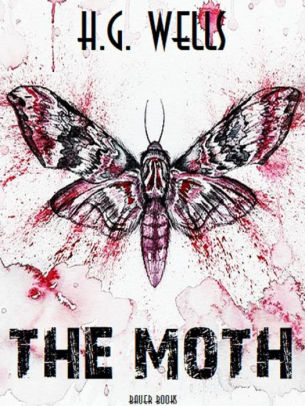“The Moth” is a short story by the English author H. G. Wells (1866–1946), first published on 28 March 1895 in The Pall Mall GazetteEvening newspaper launched in London in 1865, which introduced investigative journalism into British journalism, along with other innovations. under the title “A Moth – Genus Novo”. It was reprinted in The Stolen Bacillus and Other IncidentsCollection of 15 short stories by H. G. Wells, first published in 1895. (1895) and The Country of the Blind and Other StoriesCollection of 33 short stories by H. G. Wells, first published in 1911. (1911).[1]
The story concerns a bitter rivalry between two entomologists, ending with the death of one and the insanity of the other; it is told as a third-person narrative.
Synopsis
The dispute between Pawkins and Hapley begins when the former removes a species of lepidoptera discovered by the latter from an updated version of the Microlepidoptera, a “miracle of ineptitude” according to Hapley.

Barnes & Noble
Their dispute drags on for many years, until towards the end of his life Pawkins, the older man, publishes a paper on the mesoblast[a]The narrator observes several times that the scientific detail is irrelevant to the story: ” What the mesoblast of the Death’s Head Moth may be does not matter a rap in this story”. of the Death’s Head Moth. Pawkins is in failing health, so the work is far below his usual standard, and Hapley takes full advantage by following up with a “brutal attack” in the form of a paper on the development of moths in general. Pawkins dies of pneumonia before he can fashion a reply; “In his private thoughts, Hapley could not forgive Pawkins for dying”.
With Pawkins dead, and his twenty-year feud with the man at an end, Hapley feels a sense of void, and tries to distract himself by taking up other pursuits: reading novels, chess, and eventually the study of diatoms.[b]Diatoms are a type of algae. One evening, as he is working at his microscope, he becomes aware of a large moth or butterfly present in the room with him, apparently previously unknown to science. Hapley tries unsuccessfully to catch the insect – the head and body of which seem to remind him of Pawley – making such a racket in the process that he alarms his landlady.
The next morning Hapley goes for a walk, followed by the moth. In the afternoon he visits the local vicar, and during their conversation on “theological questions” Hapley sees the moth on the edge of the table they are sitting around, but the vicar cannot. The next day Hapley goes for a walk around some nearby chalk pits, followed by the insect. Chasing and swiping at it, he loses his footing and falls into the pits, breaking his leg. Hapley is discovered by the village doctor and confined to bed once his leg has been set, with a nurse in attendance. But the moth keeps flitting around him, at one point settling in his hair. Becoming feverish, Hapley gets out of bed to try and catch the moth, the nurse struggles with him, and Hapley becomes violent, striking out violently; as a result he is tied down to his bed. The moth becomes a constant presence during his restraint, crawling over Hapley; “while he was awake he longed for sleep, and from sleep he awoke screaming”.
The story concludes with Hapley confined to a padded cell, “worried by a moth that no one else can see”. In his more rational moments Hapley claims that the moth is the ghost of Pawkins, and as a result a unique specimen well worth his efforts to catch.
Commentary
Roslynn D. Haynes in her book H. G. Wells: Discoverer of the Future (1980) has commented that “The Moth” is one of the few stories in which “Wells explicitly considered the psychological effect of circumstances on his characters”. Hapley is consumed by using science as a way to destroy his rival’s reputation, and the void left when Pawkins dies can only be filled by Pawkins himself.[2]
The symbolism of the moth may be significant. Both moths and butterflies have literary associations with death; the Greek word psyche means “moth”, “butterfly” and “soul”.[3]
Wells reuses the literary device of falling into a pit in “The Door in the WallShort story by H. G. Wells, first published in 1906, about a man's grieving for a magical garden he had found as a child, and desperately wants to find again.” (1906) and “The Beautiful SuitShort story by H. G. Wells, first published in Collier's Weekly in April 1909 under the title "A Moonlight Fable", in which an exquisitely tailored suit leads to the death of its owner.” (1909).
See also
- H. G. Wells bibliographyList of publications written by H. G. Wells during the more than fifty years of his literary career.
Notes
| a | The narrator observes several times that the scientific detail is irrelevant to the story: ” What the mesoblast of the Death’s Head Moth may be does not matter a rap in this story”. |
|---|---|
| b | Diatoms are a type of algae. |
References
Bibliography
External links
- Full text of “The Moth” at Project Gutenberg
